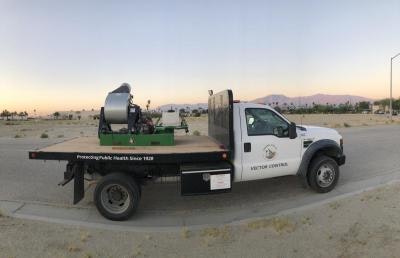Mosquito Control
Mosquito control activities are provided for many reasons. Developing an effective mosquito control program takes time, preparation, and planning. Effective planning requires strategies for addressing both routine operations and activities and emergencies caused by the risks of vector-borne disease.
By their very nature, mosquito control activities impact the environment. Therefore, every practical effort must be made to minimize the negative consequences of mosquito control on the environment. This is the foundation to integrated vector management (IVM). The District implemented a mission to evaluate and enhance our IVM program in 2014 to ensure surveillance and control methods are effective in protecting public health and environmentally sound.
Not all mosquitoes are harmful.
Targeting identifies and controls only the mosquitoes that are nuisance and disease vectors. It is more prudent to target larval mosquitoes over adults. That is because the targeted vector is more stationary and easier to target than compared to a flying adult.
The District’s operational effort to control mosquitoes is in large part directed by the distribution of the mosquito population as determined by our surveillance program.
Control of Larval Mosquitoes

Larval control is the most effective method of mosquito control. By targeting mosquito breeding sources, larval control can achieve sustainable reductions of mosquito populations using diverse microbial and chemical control product formulations.
Physical, biological, and chemical control are all tools used by the District to reduce or manage mosquito populations by keeping them within acceptable levels in addition to physical and biological control strategies.
Chemical larval control: larvicides, biorational products, insect growth regulators, and pupacides.
Control of Adult Mosquitoes
In the case of an increase in the number of mosquitoes in a particular area, or detection of an arthropod-borne virus in mosquitoes, wild birds, or humans, the District may decide to conduct ground or aerial ultra-low volume (ULV) adulticiding activities.
.png?ixlib=rb-1.1.0&w=2000&h=2000&fit=max&or=0&s=7901f87ed4b3119fa483fa9e06e892d6)
The District conducts adulticide treatments when there is an elevated public health threat from arboviruses according to the District’s risk assessment model.
Adult mosquito control is routinely performed by ultra-low volume (ULV) or barrier sprays using adulticides registered with US Environmental Protection Agency (EPA). ULV applications involve delivering a fine mist of the chemical product at specific times onto the targeted flying adult mosquitoes using special spray equipment mounted on trucks or helicopter.
Barrier applications involve the misting of tall stands of vegetation in areas with high counts of mosquitoes or elevated virus activity to control resting mosquitoes with barrier equipment attached to all-terrain vehicles (ATV) or by backpack carried by field technicians.
Ground ULV is carried out usually in urban areas with special equipment mounted on the truck.
Aerial ULV is usually carried out by helicopter or an unmanned aircraft system (drone).

The adulticides are applied at very low dosages. The low dosages, plus natural degradation by UV light and water, ensure minimal risk. The District uses pyrethroid-based products for ground and aerial ULV adulticiding. Pyrethroids are a synthetic insecticide, modeled after a botanical insecticide produced primarily from the flowers of Tanacetum cinerariaefolium, which is a species of chrysanthemum plant family, which acts as the plant’s own insecticide to keep insects away. At the time of adulticiding the District posts the information on this website as well as physical signs in the area. To be notified via email of any adulticiding activities, please sign up for notification by clicking here. If you would like to request that ground adult control applications are not made to your property, please click here for the No Treatment Request Form and the District will try to accommodate the request without jeopardizing public health. Notice: In the event of a public health emergency, and in the case of aerial applications, the District will not be able to consider any “No Treatment” requests.
What You Should Know About Invasive Mosquitoes and the Viruses They Transmit
The mosquito species capable of transmitting chikungunya, dengue, and Zika viruses have been detected in all Coachella Valley communities. While there is currently no detection of any of these viruses in mosquitoes locally, local transmission could begin if an infected traveler to the Valley is bitten by a mosquito here.
Sterile Insect Technique (SIT) is one method of reducing mosquito populations in an area of risk.
Please check out our Invasive Mosquitoes Page to learn what you can do as a community member to reduce these mosquito numbers and reduce the risk of an outbreak of mosquito-borne illness.
DISCLAIMER: The State of California has provisions in law to define public health nuisances. In the case of significant mosquito breeding sites, for example tire piles, the law allows the District to warrant fines if the owner is non-compliant.



